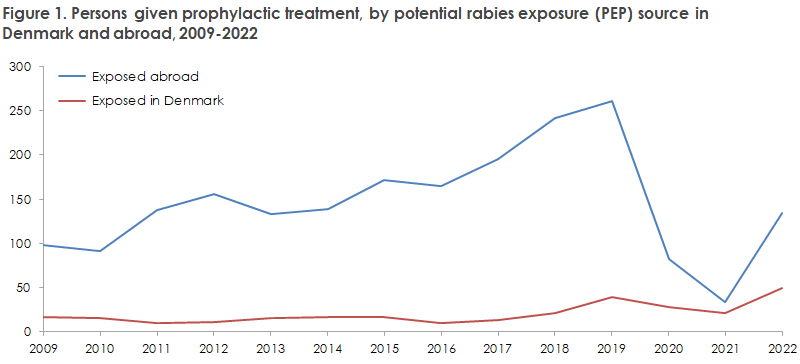No 49b - 2023
Report on rabies testing in Denmark in 2022
Report on rabies testing in Denmark in 2022
For a detailed description of post-exposure prophylaxis (PEP) and animals tested for rabies in Denmark in 2022, please see the annual report.
Increase in the number of PEP due to an increasing travel activity following COVID-19
From 2010 to 2019, the number of persons who were vaccinated abroad following potential exposure to rabies more than doubled. In 2019, the number had reached 261 treatments. Following the COVID-19 lockdown and ensuing reduced travelling activity, 2020 and 2021 recorded a steep decline to 82 and 33 persons, respectively. In 2022, the number of persons who were vaccinated abroad following potential exposure to rabies abroad increased to 134, Figure 1.
In 2022, a total of 49 persons received treatment after potential rabies exposure in Denmark. An increase was seen in the number of persons who initiated treatment following potential exposure to rabies from bats, dogs and cats in Denmark. In 2022, a total of 19 persons initiated treatment following potential exposure from bats, 16 persons from dogs and 14 persons from cats. For comparison, in 2021, a total of 14 persons initiated treatment following potential exposure to bats, six from dogs and no persons from cats. The increase in potential exposure from dogs and cats is, in part, explained by the war in the Ukraine, due to which a number of refugees from the war have brought their dogs and cats when immigrating to Denmark.

In 2022, a total of 183 persons received treatment on suspicion of rabies after having been bitten by animals. The majority (73%) initiated treatment after having been bitten by animals abroad.
The majority of those who initiated rabies PEP following bites abroad in 2022 had become exposed in Thailand or Turkey.
No one developed the disease.
Illegally imported dogs
In addition to the eight persons who were bitten by dogs imported from Ukraine, seven persons were bitten by illegally imported dogs, two from Turkey, one from Bulgaria and four persons who were bitten by the same dog from Romania.
Cats in Denmark have a low rabies risk
In 2022, a total of 14 persons initiated rabies treatment following cat bites. Half of these persons were bitten by cats from Ukraine, three were bitten by the same cat. The seven persons who received PEP after being bitten by a Danish cat had been bitten by four different cats.
Statens Serum Institut occasionally receives information about Danish cats that have changed behaviour, including showing CNS symptoms and have bitten their owners. The risk that a cat in Denmark has rabies is very low, but cats are occasionally affected by encephalitis, meningitis, etc., which may produce rabies-like symptoms.
In cases in which cats suspected of rabies are euthanised and submitted for testing, normally no indication exists for initiation of PEP treatment before a test result is available.
In cases in which a cat has been imported illegally or has been bitten by an illegally imported animal (dog/cat/ferret), the person who has been bitten/scratched initiates PEP without delay.
Poor access to rabies immunoglobulin abroad
Some persons who see healthcare staff in countries where rabies occurs endemically to receive PEP following animal bites experience that rabies immunoglobulin is unavailable. If you have previously received pre-exposure prophylaxis (PrEP) and are then subsequently exposed, receiving PEP in the form of a vaccine is sufficient - immunoglobulin is not needed. When providing guidance to persons who travel to countries where rabies is endemic, it may therefore be considered to suggest rabies prevention as part of the travel vaccines given. Particularly so, because, according to the WHO, rabies PrEP consists of only two vaccines, especially if the person expects to visit rabies endemic countries repeatedly.
A woman died of rabies in France following a cat bite in a North African country
In October 2023, a French woman died of rabies after being bitten by a cat months earlier during a travel to a North African country. This case serves as a reminder of how important it is to encourage travellers to contact Danish healthcare to receive PEP if they are bitten by an animal during travel to a country where rabies is endemic.
Rabies in animals
Classic rabies has not been observed in Denmark since 1982, whereas European bat rabies is considered to occur endemically in Danish bats.
In 2022, Denmark experienced an increase in the number of rabies suspicions in pets due to the situation in Ukraine and the considerable number of Ukrainian refugees entering Denmark, some of whom brought their pets. A total of eight cats and two dogs were tested; all tested negative. Furthermore, 11 bats and one fox were tested for rabies, all of which also tested negative.
Classic rabies virus is endemic to Greenland, where Arctic foxes occasionally transmit the infection to other mammals. In 2022, a total of nine Arctic foxes from Greenland were tested. In five of the nine foxes, classic rabies virus was found.
(A.K. Hvass, S. Cowan, Department of Infectious Disease Epidemiology and Prevention, T. B. Rasmussen, Department for Virus and Microbiological Special Diagnostics)
6 December 2023